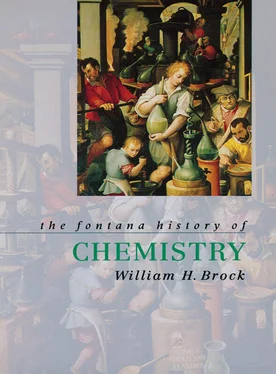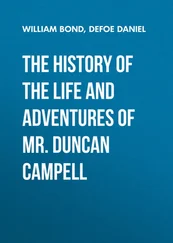Boyle concluded, therefore, that fire analysis was totally unsuited to demonstrating that substances are all composed of the same number of elements. To do this was like affirming ‘that all words consist of the same letters’. Such a critique of the Aristotelian elements was by no means unique to Boyle. Indeed, there is considerable evidence that, apart from his own original experiments, he drew the main thrust of the critique from the writings of Gassendi, who had made similar points when reviving the atomic philosophy of Epicurus and Lucretius.
Once this is realized, the point of his objections to the three principles of Paracelsus becomes plain. Lying in the background to the ‘Reflexions’, and made explicit in The Sceptical Chymist , was a corpuscular philosophy. Boyle’s argument was that, even if there were three principles or elements inside a material, it did not necessarily follow that an analysis into these three parts was possible, or that they were the ultimate parts. Oddly enough, nineteenth-century organic chemists were to be faced by exactly the same problem: what guarantee was there that the products of a reaction told one anything about the original substance?
It is not altogether unquestionable that if three principles be separated from bodies, they were pre-existent in them; for, perhaps, when fire dos sever the parts of bodies, the igneous atoms doe variously associate themselves with the disjoined particles of the dissolved body, or else make severall combinations of the freed principles of the same body betwixt themselves, and by that union, or at least cohesion, there may result mixts of a new sort.
As Laurent discovered in the 1830s, such scepticism is valuable; but if taken too literally, it would prevent any use of reactions as evidence of composition.
Boyle therefore concluded of the Paracelsian principles that, until such time as someone analysed gold and similar substances into three consistent parts, ‘I will not deny it to be possible absolutely … yet must I suspend my belief, till either experience or competent testimony hath convinced me of it’.
There was one further card up Boyle’s sleeve; he was able to use the Helmontian theory of one element as an argument against the alternative three- and four-element theories. He appears at first to have had strong doubts concerning the truth of Helmont’s water hypothesis; but after experiments of his own he had to admit that it seemed plausible. In both the ‘Reflexions’ and The Sceptical Chymist , Helmont’s work appears in a favourable light. Nearly a third of the ‘Reflexions’ is devoted to a discussion of Helmont’s work. Some of Boyle’s own experiments seemed to support the water theory, though he remained agnostic on the question whether or not water was truly elementary. Indeed, in The Sceptical Chymist he argued that water itself was probably an agglomeration of particles.
Boyle’s experiments were very similar to those of Helmont:
I have not without some wonder in the analysis of bodies, marvelled how great a share of water goes to the making up of divers, whose disguise promises nothing neer so much. Some hard and solid woods yield more of water alone than all the other elements. The distillation of eels, though it yields some oile, and spirit, and volatile salt, besides the caput mortum, yet were all these so disproportionate to the water that came from them … that they seemed to have been nothing, but coagulated phlegme.
Boyle’s own astute version of the willow tree experiment, after verification with a squash or marrow seed left to grow in a pot for five months, involved growing mint in water alone, for, as he reasoned, if the plant drew its substance entirely from water, the presence of earth in which to grow the seed or shoot was irrelevant.
Helmont’s position, based upon a thorough experimental foundation, seemed on the face of things very attractive. But Boyle could find no evidence for the growth of metals or minerals from water; neither could he see how plant perfumes and nectars arose from water alone. There was no evidence that an alcahest existed and, in any case, the mechanical philosophy saw no ultimate physical difference between a solvent and a solute. Thus although Helmont’s experiments were a useful stick with which to beat the Aristotelian and Paracelsian theories of elements, Boyle was no partisan of Helmont’s alternative interpretation.
On the other hand, Helmont’s theory appealed to Boyle’s Biblical literalism, for the world, according to Genesis and Hebrew mythologies, had emerged ‘by the operation of the Spirit of God,… moving Himself as hatching females do … upon the face of the water’. This original water could never have been elementary, but must have consisted ‘of a great variety of seminal principles and rudiments, and of other corpuscles fit to be subdued and fashioned by them’. Possibly, then, common water had retained some of this original creative power.
Boyle’s advice on the whole question of the evidence for the existence of elements was to keep an open mind and a sceptical front.
The surest way is to learne by particular experiments what heterogeneous parts particular bodies do consist of, and by what wayes, either actual or potential fire, they may best and most conveniently be separated without fruitlessly contending to force bodies into more elements than Nature made them up of, or strip the severed principles so naked, as by making them exquisitely elementary, to make them laboriously uselesse.
There was irony in that final remark, for through his adherence to the corpuscular philosophy Boyle proceeded to make the concept of the element ‘laboriously uselesse’. Before pursuing this point, however, what sceptical mischief did Boyle wreak on the acid – alkali theory?
This theory was not discussed in either The Sceptical Chymist or its manuscript draft version. Instead, Boyle criticized Sylvius’ and Tachenius’ views in 1675 in Reflections upon the Hypothesis of Alcali and Acidium. Ten years previously, in his Experimental History of Colours (see chapter 5), Boyle had made an important contribution to acid – base chemistry with the development of indicators. He had found that a blue vegetable substance, syrup of violets, turned red with acids and green with alkalis. The test was applicable to all the known acids and could be used confidently to give a working definition of an acid: namely, that an acid was a substance that turned syrup of violets red. The test was also quantitative in a rough-and-ready way, since neutral points could be determined.
When Boyle came to consider the Sylvius – Tachenius theory in 1675, he was able to object to the vagueness of the terms ‘acid’ and ‘alkali’ as commonly used in the theory. Effervescence, he pointed out, was not a good test of acidity, since it was also the test for alkalinity; it also created difficulties with the metals, which effervesced when added to acids. Were metals alkalis? If zinc was reacted with the alkali called soda (sodium carbonate), it was dissolved. Was zinc, therefore, an acid?
Whereas in The Sceptical Chymist Boyle had only played the critic and not put forward any concrete proposal to replace the Aristotelian and Paracelsian theories, in the case of his criticism of the acid – alkali theory, he was able to offer an alternative, experimentally based classification of acidic, alkaline and neutral solutions, which could be used helpfully in chemical analysis. By building on this experimental work, succeeding chemists were able to develop the theory of salts, which proved one of the starting points for Lavoisier’s revision of chemical composition in the eighteenth century.
There was also a second important criticism of the acid – alkali theory. In its vague metaphorical talk of ‘strife’ between acidic and alkaline solutions, the theory possessed a decidedly unmechanical, indeed, anti-mechanical, air about it. To a corpuscular philosopher like Boyle, the theory was occult, in the seventeenth-century sense that it appealed to explanations that could not be reduced to the mechanical geometrical principles of size, shape and motion with which God had originally endowed them. Even so, it is doubtful whether Boyle subscribed fully to the reduction of chemical properties to geometrical qualities, as early eighteenth-century philosophers were to do. The most Boyle was prepared to argue was that chemical properties depended on the way the particles that composed one body were disposed to react with those of others.
Читать дальше












